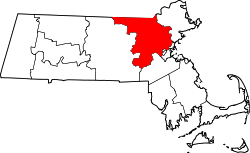Newton Centre, Massachusetts | |
|---|---|
Village | |
| The intersection of Beacon and Centre Streets, with Newton Centre Green on the left | |
| Coordinates: 42°19′50″N71°11′40″W / 42.33056°N 71.19444°W | |
| Country | |
| State | Massachusetts |
| County | Middlesex |
| City | Newton |
| Elevation | 300 ft (91 m) |
| Time zone | UTC-5 (Eastern (EST)) |
| • Summer (DST) | UTC-4 (EDT) |
| ZIP Code | 02459 |
| Area codes | 617 and 857 |
Newton Centre is one of the thirteen villages within the city of Newton in Middlesex County, Massachusetts, United States. The main commercial center of Newton Centre is a triangular area surrounding the intersections of Beacon Street, Centre Street, and Langley Road. It is the largest downtown area among all the villages of Newton, and serves as a large upscale shopping destination for the western suburbs of Boston. The Newton City Hall and War Memorial is located at 1000 Commonwealth Avenue, [1] and the Newton Free Library is located at 330 Homer Street in Newton Centre. The Newton Centre station of the MBTA Green Line "D" branch is located on Union Street.
Contents
- Education
- K-12 Education
- Colleges and universities
- Notable people
- Attractions and landmarks
- Buildings (excluding houses)
- Historic houses
- Historic districts
- Historic pictorial map
- See also
- References
- External links
The Crystal Lake and Pleasant Street Historic District is roughly bounded by the Sudbury Aqueduct, Pleasant Avenue, Lake Avenue, and Crystal Street and Webster Court. This area and its surrounding neighborhoods exemplify the distinct styles of the late 19th century and early 20th century.
Crystal Lake, a 33-acre natural lake, is a popular swimming spot for locals in the area.



